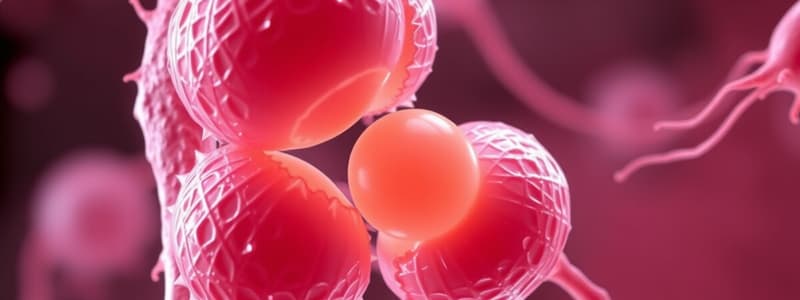Podcast
Questions and Answers
What is the primary purpose of interkinesis during cell division?
What is the primary purpose of interkinesis during cell division?
- It stimulates the formation of spindle fibers.
- It allows for decondensing chromosomes and reforming the nucleus. (correct)
- It involves the separation of homologous chromosomes.
- It prepares the cell for DNA replication.
During which phase of meiosis do sister chromatids separate?
During which phase of meiosis do sister chromatids separate?
- Prophase II
- Anaphase I
- Anaphase II (correct)
- Metaphase II
Which of the following correctly describes cytokinesis in the context of meiosis?
Which of the following correctly describes cytokinesis in the context of meiosis?
- It is identical to mitosis with haploid daughter cells. (correct)
- It results in one daughter cell receiving all cytoplasmic contents.
- Cytokinesis does not occur after meiosis II.
- Daughter cells are diploid with 2 copies of each chromosome.
What affects the positioning of the contractile ring during cytokinesis?
What affects the positioning of the contractile ring during cytokinesis?
Which statement best describes the impact of asymmetrical cell division in embryogenesis?
Which statement best describes the impact of asymmetrical cell division in embryogenesis?
At what stage does oogenesis arrest before puberty?
At what stage does oogenesis arrest before puberty?
In cytokinesis, what is the primary mechanism by which the cytoplasm divides?
In cytokinesis, what is the primary mechanism by which the cytoplasm divides?
What aspect of oogenesis is highlighted as significant in fertility studies?
What aspect of oogenesis is highlighted as significant in fertility studies?
What is the role of the Arp2/3 complex in actin dynamics?
What is the role of the Arp2/3 complex in actin dynamics?
Which statement accurately describes the function of BCL-2 in apoptosis regulation?
Which statement accurately describes the function of BCL-2 in apoptosis regulation?
During which phase does the cell arrest before fertilization in females?
During which phase does the cell arrest before fertilization in females?
What characterizes the process of necrosis compared to apoptosis?
What characterizes the process of necrosis compared to apoptosis?
Which of the following statements about cellular signaling changes is true?
Which of the following statements about cellular signaling changes is true?
What is the primary function of autophagy in cellular processes?
What is the primary function of autophagy in cellular processes?
Which component is necessary for the polymerization of microtubules?
Which component is necessary for the polymerization of microtubules?
Which stage follows membrane nucleation in macroautophagy?
Which stage follows membrane nucleation in macroautophagy?
What is the function of the Arp2/3 complex in cellular dynamics?
What is the function of the Arp2/3 complex in cellular dynamics?
How does an increase in BCL-2 affect cellular processes?
How does an increase in BCL-2 affect cellular processes?
What role do cyclins play in regulating CDK activity?
What role do cyclins play in regulating CDK activity?
Which type of vesicular trafficking is associated with the movement from the rough endoplasmic reticulum to the plasma membrane?
Which type of vesicular trafficking is associated with the movement from the rough endoplasmic reticulum to the plasma membrane?
What is the consequence of a loss of MAD2 in the context of mitosis?
What is the consequence of a loss of MAD2 in the context of mitosis?
What is the function of DREAM in the cell cycle?
What is the function of DREAM in the cell cycle?
Which of the following best describes the role of dynein in vesicular trafficking?
Which of the following best describes the role of dynein in vesicular trafficking?
During which stage of the cell cycle is Cyclin E/CDK2 active?
During which stage of the cell cycle is Cyclin E/CDK2 active?
What is the effect of increased levels of Arp2/3 on cell motility?
What is the effect of increased levels of Arp2/3 on cell motility?
What mechanism does apoptosis primarily use for cellular self-destruction?
What mechanism does apoptosis primarily use for cellular self-destruction?
Which cellular structure is crucial for the sorting and exporting of proteins?
Which cellular structure is crucial for the sorting and exporting of proteins?
What is a potential outcome of losing function in the BCL-2 protein?
What is a potential outcome of losing function in the BCL-2 protein?
Which coating proteins enable retrograde vesicular transport?
Which coating proteins enable retrograde vesicular transport?
What is the outcome when there is a failure in cytokinesis?
What is the outcome when there is a failure in cytokinesis?
Flashcards are hidden until you start studying
Study Notes
Oogenesis and Meiosis
- After puberty, oocytes enter a state of arrest at metaphase II until fertilization.
- Ovulation triggers the release of arrested oocytes, allowing meiosis to resume.
- Human disease can arise from genetic variations affecting cellular behavior and protein function.
- Cellular impacts include changes in signaling, growth, differentiation, and apoptosis, leading to either pathogenic, benign, or uncertain outcomes.
Necrosis vs. Apoptosis
- Necrosis: Harmful, causes damage to neighboring cells through leakage of cellular contents; associated with changes in ions, osmolarity, and pH.
- Apoptosis: Non-harmful, involves controlled processes with DNA nucleases leading to organized destruction of DNA; can be stimulated and engages mitochondria to manage cell contents.
Autophagy Process
- Involves macroautophagy with stages: upstream signal initiation, membrane nucleation, autophagosome elongation and closure, lysosomal fusion, and final degradation/release of contents.
Cytoskeletal Components
- Actin: Polymerizes using ATP hydrolysis; nucleation and branching facilitated by the Arp2/3 complex.
- Microtubules: Form via GTP hydrolysis from alpha-beta tubulin dimers.
Cell Cycle Regulation
- Players promoting division include CDK activity (regulated by cyclins) and E2F transcription.
- Players suppressing division include p21, DREAM complex, and hypophosphorylation protocols.
Mitosis Stages
- Prophase: Chromosomes condense; spindle apparatus forms; potential for cytoskeletal issues.
- Metaphase: Chromosomes align at the metaphase plate; critical checkpoint for chromosome segregation.
- Anaphase: Sister chromatids separate due to breakdown of cohesins.
- Telophase: Chromosomes reach poles; nuclear envelope reforms; potential for consequences if cytokinesis fails.
- Cytokinesis: Division of the cytoplasm, requiring actin, myosin, and microtubules.
Meiosis Summary
- Prophase I: Chromosome condensation; crossing-over occurs.
- Metaphase I: Random alignment of homologous chromosomes on the metaphase plate.
- Anaphase I: Segregation of homologous chromosomes.
- Telophase I: Chromosomes arrive at poles; may include nuclear envelope reformation.
- Interkinesis: Period between divisions with variability in chromosome behavior.
- Prophase II: Resembles prophase I, requiring new spindle formation.
- Completion leads to haploid daughter cells post-cytokinesis.
Cytokinesis and Polarity
- In somatic mitosis, cytokinesis typically achieves equal distribution of cytoplasmic contents.
- Asymmetric divisions during embryogenesis promote concentration gradients of materials leading to unique cellular properties and gene expressions vital for morphogenesis.
Oogenesis Insights
- Human oogenesis involves significant prenatal cell loss; mechanisms remain largely unknown and are a key area in fertility research.
- There are two distinct pauses in meiosis during oogenesis: the first at prophase I before puberty.
Studying That Suits You
Use AI to generate personalized quizzes and flashcards to suit your learning preferences.




